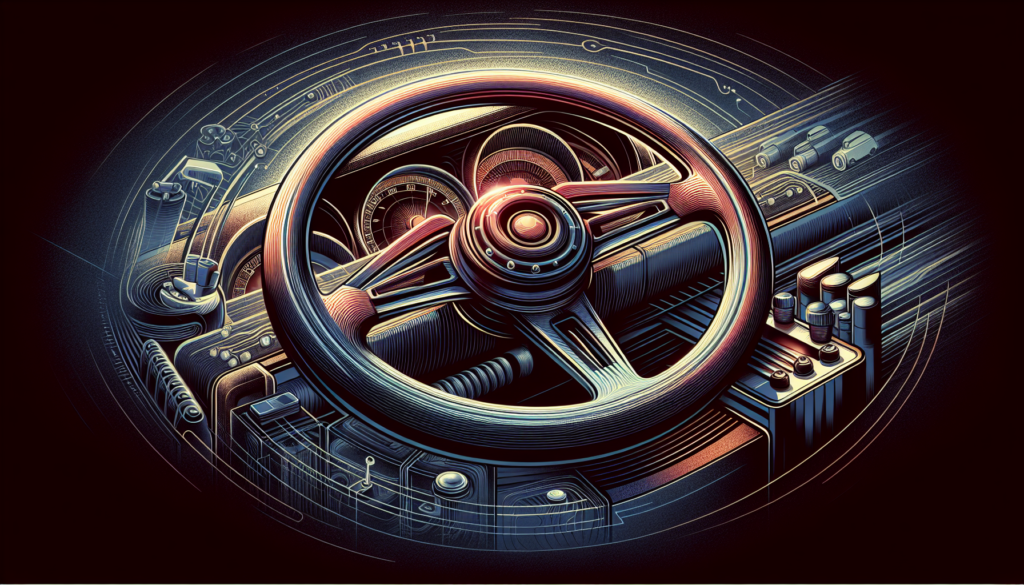Imagine driving down the road, hands gripping the steering wheel, feeling a rumbling sensation through your fingertips. As the car veers slightly to the left, you start to wonder – could this be a result of poor wheel alignment? In this article, we explore the connection between wheel alignment and vehicle handling. Discover how this often-overlooked aspect of car maintenance can have a significant impact on your overall driving experience. Strap in and let’s hit the road to uncover the truth behind wheel alignment and its effect on your vehicle’s handling.
What is Wheel Alignment
Definition and Explanation
Wheel alignment refers to the process of adjusting the angles of the wheels so that they are perpendicular to the ground and parallel to each other. It is an essential maintenance procedure for vehicles to ensure optimal performance and safety on the road. Proper wheel alignment plays a crucial role in maintaining the stability, handling, and overall performance of a vehicle.
Importance of Proper Wheel Alignment
Having proper wheel alignment is vital for several reasons. Firstly, it ensures that the tires make maximum contact with the road surface, resulting in better traction and control. This is especially important during cornering and braking maneuvers. Secondly, correct wheel alignment reduces tire wear, prolonging the lifespan of the tires and saving you money in the long run. Additionally, it enhances fuel efficiency by reducing rolling resistance, thus improving gas mileage. Lastly, proper wheel alignment promotes a comfortable ride by minimizing vibrations and steering wheel pull.
Effects of Improper Wheel Alignment
Uneven Tire Wear
Improper wheel alignment can lead to uneven tire wear, which can be costly and inconvenient. When the wheels are not aligned correctly, certain areas of the tire tread will experience more friction than others, resulting in uneven wear patterns. This uneven wear can cause tires to wear out quicker, leading to premature tire replacement and decreased performance.
Vehicle Pulling
Another effect of improper wheel alignment is vehicle pulling. When the wheels are misaligned, one or more tires may exert more force than the others, causing the vehicle to veer in one direction. This pulling effect can be frustrating and dangerous, especially when driving on highways or in heavy traffic. It requires constant steering correction, which can fatigue the driver and adversely affect the overall handling of the vehicle.
Steering Wheel Vibration
Improper wheel alignment can also cause steering wheel vibration. When the wheels are not aligned correctly, they may not rotate smoothly, leading to vibrations that can be felt in the steering wheel. These vibrations can be uncomfortable for the driver and may indicate other underlying issues, such as unbalanced tires or worn suspension components. Steering wheel vibrations can affect the overall handling and stability of the vehicle, making it more difficult to control.
Poor Handling
One of the most noticeable effects of improper wheel alignment is poor handling. When the wheels are misaligned, it can affect the vehicle’s ability to respond accurately to steering inputs. This can result in a sluggish and unresponsive feel, making it challenging to navigate corners or maneuver safely. Additionally, improper wheel alignment can compromise the vehicle’s stability, making it more prone to swaying or drifting on the road. Poor handling not only affects the overall driving experience but also poses potential safety risks.

Wheel Alignment Parameters
Camber
Camber refers to the angle at which the wheels tilt inward or outward when viewed from the front of the vehicle. It is measured in degrees and can be either positive or negative. Positive camber means that the tops of the wheels tilt outward, while negative camber means that the tops of the wheels tilt inward.
Toe
Toe refers to the angle at which the wheels point inward or outward when viewed from above the vehicle. It can be measured in degrees and can be either positive or negative. Positive toe means that the front edges of the tires point inward, while negative toe means that the front edges of the tires point outward.
Caster
Caster refers to the angle of the steering axis in relation to the vertical axis when viewed from the side of the vehicle. It is measured in degrees and can be either positive or negative. Positive caster means that the steering axis tilts toward the rear of the vehicle, while negative caster means that the steering axis tilts toward the front of the vehicle.
Camber
Definition and Explanation
Camber refers to the vertical tilt of the wheels when viewed from the front of the vehicle. It is a key wheel alignment parameter that affects the contact patch of the tires with the road surface. Positive camber occurs when the tops of the wheels tilt outward, away from the vehicle’s centerline. Negative camber, on the other hand, occurs when the tops of the wheels tilt inward, towards the vehicle’s centerline.
Effects on Vehicle Handling
Camber has a significant impact on the vehicle’s handling characteristics. Positive camber can enhance stability during straight-line driving, as it helps the wheels to track in a parallel manner. However, excessive positive camber can lead to reduced cornering grip, as the weight of the vehicle is shifted to the outer edges of the tires. Negative camber, on the other hand, improves cornering grip by maximizing the contact patch during turns. However, too much negative camber can result in uneven tire wear, reduced straight-line stability, and increased steering effort.
Signs of Camber Misalignment
Signs of camber misalignment can be observed through visual inspection of the tires. Excessive positive camber may cause wear on the outer edges of the tires, while excessive negative camber can result in wear on the inner edges. Uneven tire wear can lead to reduced tire life and compromised handling performance. Additionally, camber misalignment may cause the vehicle to pull to one side, resulting in an uneven steering feel.
Causes of Camber Misalignment
Camber misalignment can be caused by a variety of factors, including worn or damaged suspension components, such as control arms or ball joints. A collision or impact with a pothole or curb can also lead to camber misalignment. Additionally, improper installation of suspension components or modifications to the suspension system can result in camber misalignment.
Importance of Proper Camber Alignment
Proper camber alignment is crucial for maintaining optimal tire wear, handling, and overall vehicle performance. Correct camber settings ensure that the tires make consistent and even contact with the road surface, promoting balanced handling and maximizing traction. Proper camber alignment can help extend the lifespan of the tires, improve fuel efficiency, and enhance the overall driving experience.

Toe
Definition and Explanation
Toe refers to the angle at which the wheels point inward or outward when viewed from above the vehicle. It is a critical wheel alignment parameter that affects the vehicle’s stability, cornering ability, and tire wear. Toe can be measured in degrees and can be either positive or negative. Positive toe occurs when the front edges of the tires point inward, while negative toe occurs when the front edges of the tires point outward.
Effects on Vehicle Handling
Toe alignment plays a crucial role in the vehicle’s handling characteristics. Proper toe settings ensure that the tires roll in a straight line, resulting in stable and predictable handling. Positive toe promotes straight-line stability but can lead to increased tire wear during cornering. Negative toe improves cornering ability by enhancing turn-in response and reducing understeer. However, excessive negative toe can cause increased tire wear and instability during straight-line driving.
Signs of Toe Misalignment
Misalignment of toe can be indicated by certain visual cues and handling characteristics. Uneven tire wear, particularly on the outer or inner edges of the tires, may indicate toe misalignment. Additionally, a vehicle that constantly pulls to one side, even on a level road, may be experiencing toe misalignment. Vibrations in the steering wheel or a vague and imprecise steering feel can also be signs of toe misalignment.
Causes of Toe Misalignment
Toe misalignment can occur due to various factors, including worn or damaged steering and suspension components. Over time, components such as tie rods, control arms, and bushings can wear out, leading to toe misalignment. Additionally, a collision or impact with a pothole or curb can cause toe misalignment. Improper installation of suspension components or modifications to the suspension system can also result in toe misalignment.
Importance of Proper Toe Alignment
Proper toe alignment is essential for maintaining tire wear, stability, and overall vehicle performance. Correct toe settings ensure that the tires roll parallel to each other, reducing scrubbing and ensuring even tire contact with the road surface. This promotes better handling, improved fuel efficiency, and maximizes the lifespan of the tires. Proper toe alignment also reduces the likelihood of vehicle pulling and helps maintain a smooth and stable steering feel.
Caster
Definition and Explanation
Caster is an often overlooked but crucial wheel alignment parameter that refers to the angle of the steering axis in relation to the vertical axis when viewed from the side of the vehicle. It affects the stability, steering feel, and self-centering ability of the vehicle. Caster can be measured in degrees and can be either positive or negative. Positive caster occurs when the steering axis tilts toward the rear of the vehicle, while negative caster occurs when the steering axis tilts toward the front of the vehicle.
Effects on Vehicle Handling
Caster alignment has a significant impact on the vehicle’s handling characteristics. Positive caster provides stability, as it tends to make the front wheels self-center when the vehicle is traveling straight ahead. This enhances straight-line stability and improves the vehicle’s resistance to wandering or drifting. Moreover, positive caster can improve high-speed stability and enhance the overall steering feel of the vehicle. On the other hand, negative caster can result in reduced straight-line stability and may lead to steering wander and a vague steering feel.
Signs of Caster Misalignment
Caster misalignment can be difficult to identify visually. However, certain signs may indicate caster misalignment. A vehicle that pulls to one side, even on a level road, may be experiencing caster misalignment. Additionally, steering wheel off-center or a steering wheel that does not self-center after making a turn can be signs of caster misalignment. Uneven tire wear, particularly on the inner or outer edges, may also be an indication of caster misalignment.
Causes of Caster Misalignment
Caster misalignment can be caused by various factors, including worn or damaged suspension components, such as control arms or strut assemblies. A collision or impact with a pothole or curb can also lead to caster misalignment. Additionally, improper installation of suspension components or modifications to the suspension system can result in caster misalignment.
Importance of Proper Caster Alignment
Proper caster alignment is essential for optimal steering stability, handling, and overall vehicle performance. Correct caster settings ensure that the vehicle tracks straight and true, providing a balanced and confident driving experience. Proper caster alignment promotes better high-speed stability, improves the vehicle’s resistance to pulling, and enhances the vehicle’s self-centering ability. It also contributes to a more precise steering feel and helps maintain tire wear and fuel efficiency.

Alignment Adjustments and Maintenance
Alignment Procedures
Wheel alignment procedures are typically performed by professionals using specialized equipment and tools. The process involves measuring and adjusting the various alignment angles, including camber, toe, and caster, to meet the manufacturer’s specifications. This ensures that the wheels are properly aligned and that the vehicle’s handling characteristics are optimized.
Alignment Equipment and Tools
The wheel alignment process requires specific equipment and tools designed for accurate and precise measurements. Alignment machines and computerized systems are used to measure the angles of the wheels and provide real-time data to the technician. Additionally, alignment equipment includes turnplates, alignment heads, and laser or sensor alignment tools. These tools ensure that the alignment process is performed correctly and efficiently.
When to Get a Wheel Alignment
It is recommended to have a wheel alignment performed whenever there are signs of misalignment or uneven tire wear. Additionally, it is a good idea to schedule a wheel alignment when replacing tires or after any suspension work or modifications. Regular maintenance schedules provided by the vehicle manufacturer may also indicate when a wheel alignment should be performed. Overall, it is important to address wheel alignment issues promptly to prevent potential damage to tires, suspension components, and other parts of the vehicle.
Alignment Maintenance Tips
To maintain proper wheel alignment, there are a few maintenance tips that can be followed. Regularly inspecting tires for signs of wear and damage is crucial. Additionally, ensuring proper tire inflation according to the manufacturer’s recommended pressures can help maintain alignment settings. Avoiding rough roads, potholes, and curbs whenever possible can also minimize the risk of misalignment. Lastly, it is important to have the vehicle’s suspension components inspected and serviced regularly to ensure they are in good working condition.
Professional Wheel Alignment vs. DIY
Benefits of Professional Wheel Alignment
Getting a wheel alignment performed by a professional has several advantages. Professional technicians have the knowledge, experience, and specialized equipment to accurately measure and adjust wheel alignment angles. They can ensure that the alignment is performed correctly, meeting the manufacturer’s specifications. Additionally, professional wheel alignments often come with a warranty or guarantee, providing peace of mind.
Drawbacks of DIY Alignment
Attempting to perform a wheel alignment as a DIY project can be challenging and may lead to inaccurate results. Without the proper knowledge, experience, and equipment, it can be difficult to accurately measure and adjust the alignment angles. Incorrect alignment settings can result in further damage to the vehicle, increased tire wear, and compromised handling. Additionally, any DIY alignment adjustments may void the vehicle’s warranty or extended warranty.
When DIY Alignment Can Be Sufficient
In some cases, DIY alignment can be sufficient if the vehicle is equipped with adjustable suspension components and the owner has the necessary knowledge and experience. However, it is crucial to follow proper procedures and guidelines to ensure accurate measurements and adjustments. DIY alignment should only be attempted by those with the requisite skills and knowledge, and it is always recommended to consult with a professional technician when in doubt.

Common Wheel Alignment Issues
Misalignment Due to Suspension Damage
Damage to the suspension components, such as control arms, ball joints, or struts, can lead to wheel alignment issues. Wear and tear over time, as well as accidents or collisions, can cause these components to become misaligned. It is important to address any suspension damage promptly and have the necessary repairs performed to restore proper wheel alignment.
Misalignment from Potholes and Rough Roads
Driving over potholes, rough roads, or other road hazards can cause the wheels to become misaligned. The impact from hitting these obstacles can throw off the alignment angles, leading to poor handling and uneven tire wear. It is important to avoid rough roads whenever possible and drive cautiously to minimize the risk of misalignment.
Misalignment after Suspension Modifications
Making modifications to the suspension system, such as installing lowering springs, coilovers, or aftermarket suspension components, can affect wheel alignment. These modifications can change the alignment angles, requiring adjustments to be made to maintain proper alignment. It is advisable to consult with a professional technician familiar with suspension modifications to ensure that the alignment is correctly adjusted after any modifications.
Conclusion
Proper wheel alignment is crucial for maintaining optimal vehicle handling, performance, and safety. It affects tire wear, stability, steering response, and fuel efficiency. Understanding the different alignment parameters, such as camber, toe, and caster, helps in recognizing the signs of misalignment and the importance of proper alignment settings. While it is recommended to have wheel alignments performed by professionals, occasional DIY alignment may be sufficient for those with the necessary skills and knowledge. Regular maintenance and addressing any alignment issues promptly can help preserve the overall performance and longevity of a vehicle. By prioritizing proper wheel alignment, you can enjoy a safer and more enjoyable driving experience.


